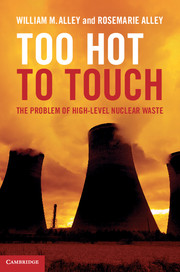Book contents
- Frontmatter
- Contents
- Acknowledgments
- List of units
- List of abbreviations
- Introduction
- Part I The problem
- 1 The awakening
- 2 Brainstorming
- 3 The ocean as a dumping ground
- 4 Radioactivity and atomic energy
- 5 The Cold War legacy
- 6 The peaceful atom and its wastes
- 7 Recycling
- 8 Dry cask storage
- 9 Interim storage
- 10 A can of worms
- 11 WIPP
- Part II The mountain
- Part III No solution in sight
- Appendix Discussion questions
- References
- Index
2 - Brainstorming
from Part I - The problem
Published online by Cambridge University Press: 05 February 2013
- Frontmatter
- Contents
- Acknowledgments
- List of units
- List of abbreviations
- Introduction
- Part I The problem
- 1 The awakening
- 2 Brainstorming
- 3 The ocean as a dumping ground
- 4 Radioactivity and atomic energy
- 5 The Cold War legacy
- 6 The peaceful atom and its wastes
- 7 Recycling
- 8 Dry cask storage
- 9 Interim storage
- 10 A can of worms
- 11 WIPP
- Part II The mountain
- Part III No solution in sight
- Appendix Discussion questions
- References
- Index
Summary
The general public can be divided into two parts: those that think science can do everything, and those who are afraid it will.
Dixy Lee RayThere is a strong worldwide consensus that disposal in a geologic repository is the only feasible, permanent solution to the high-level waste problem. The concept seems simple and comes to mind almost instinctively – bury the waste in a hole excavated in rocks deep underground. Burial in deep geological formations provides more than adequate shielding from the waste's radiation and decreases the likelihood of inadvertent or malicious intrusion by humans. Yet, this international consensus favoring geologic burial is the product of decades of brainstorming. No matter how outlandish or seemingly impossible, one by one, each conceivable solution was given its turn at the table.
In these early discussions, one idea stood apart from the rest. In April 1951, Representative Albert Gore, Sr. (D-TN), father of Nobel Peace Prize winning Al Gore, suggested using radioactive waste from the Nation’s plutonium production to “dehumanize” a belt across the entire 38th parallel of the Korean peninsula. The contamination would prevent further attacks by Communist forces invading from the North. Yet, the most important result would be “its psychological effect as a mystery weapon, analogous to the initial use of poison gas and of tanks in World War I.” Representative Gore argued that such widespread use of radioactive waste was morally justified as a deterrent, rather than an attack strategy. The enemy would be duly forewarned. Gore had in mind relatively short-lived isotopes. He added that the belt would need to be replenished periodically with new wastes, until a “satisfactory solution to the whole Korean problem” was reached.
- Type
- Chapter
- Information
- Too Hot to TouchThe Problem of High-Level Nuclear Waste, pp. 21 - 28Publisher: Cambridge University PressPrint publication year: 2012



